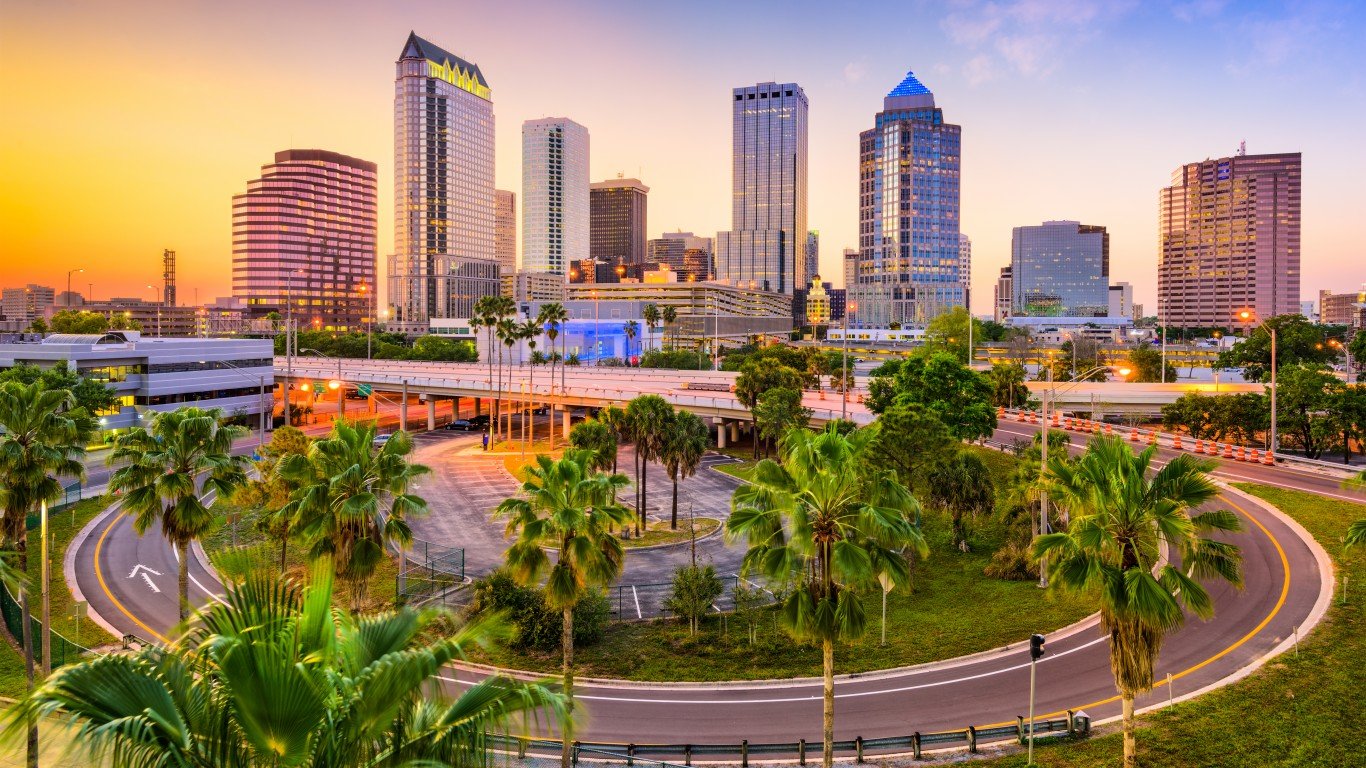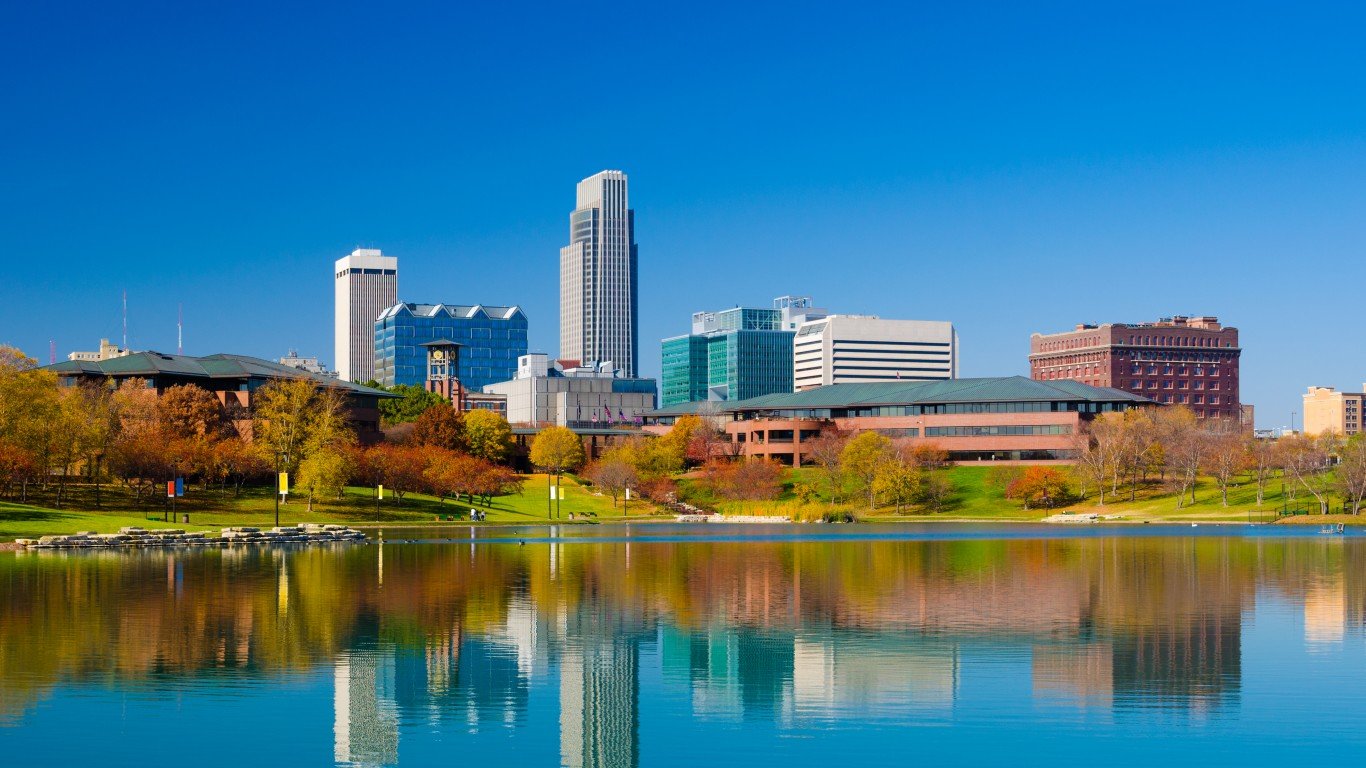20. Montana
> Population: 1,104,271 (+1.8% in last year)
> Life expectancy at birth: 78.4 years (23rd lowest)
> Median household income: $63,249 (16th lowest)
> Median home value: $322,800 (17th highest)
> Median housing costs as pct. of income: 16.9% (23rd highest)
> August 2022 unemployment: 2.6% (8th lowest)
In key measures of quality of life, Montana ranks in the better half of the 50 states. While the state gets less sunlight, on average, than most other states, it also has some of the cleanest air in the United States. It has one of the lower concentrations among states of microscopic particulate matter, long-term exposure to which can reduce lung function and increase the risk of mortality from lung cancer and heart disease.
Montana also compares favorably in certain economic measures. Though the state’s median household income of $63,249 is about $6,500 below the national median, its poverty rate of 11.9% is nearly a full percentage point below the national poverty rate of 12.8%. Montana’s job market is also relatively strong, with an August unemployment rate of only 2.6%, compared to the 3.8% national jobless rate.

19. Washington
> Population: 7,738,692 (+0.4% in last year)
> Life expectancy at birth: 80.2 years (5th highest)
> Median household income: $84,247 (7th highest)
> Median home value: $485,700 (3rd highest)
> Median housing costs as pct. of income: 18.9% (9th highest)
> August 2022 unemployment: 4.1% (14th highest)
Home values can be indicative of an area’s desirability, and in Washington state, the typical home is worth $485,700, more than the typical home value in all but two other states. Incomes are also high in the state, with the typical household earning $84,247 a year, about $14,500 more than the national median household income.
Washington also has some of the cleanest air in the country, with relatively low concentrations of harmful, microscopic particulate matter. Factors like high incomes and low levels of air pollution are linked to better health outcomes across broad populations. In Washington, average life expectancy at birth is 80.2 years, fifth highest among states.

18. Florida
> Population: 21,781,128 (+1.1% in last year)
> Life expectancy at birth: 79.7 years (11th highest)
> Median household income: $63,062 (15th lowest)
> Median home value: $290,700 (21st highest)
> Median housing costs as pct. of income: 18.4% (13th highest)
> August 2022 unemployment: 2.8% (10th lowest)
Florida ranks among the better half of all states for overall quality of life and it ranks as one of the best states to live in in the South. It has a warm climate and gets more sun, on average, than nearly every other state. The state’s job market is relatively strong, with an unemployment rate of just 2.8% as of August 2022, a full percentage point below the national rate. Florida is also growing its population rapidly. Considering only net migration and excluding natural growth – births minus deaths – the state’s population expanded by 1.4% from 2020 to 2021, the sixth largest such increase of any state.
Still, Florida is not without some drawbacks, namely, a less affordable housing market. The state has a lower than average median household income and a higher than average median home value, and median housing costs – considering both renters and homeowners – account for 18.4% of the income the typical household earns, above the 17.4% national ratio.

17. Nebraska
> Population: 1,963,692 (+0.1% in last year)
> Life expectancy at birth: 79.0 years (19th highest)
> Median household income: $66,817 (24th highest)
> Median home value: $204,900 (14th lowest)
> Median housing costs as pct. of income: 16.5% (22nd lowest)
> August 2022 unemployment: 2.2% (5th lowest)
Nebraska ranks as the second best state for quality of life in the Midwest, trailing only Minnesota. The state has some of the cleanest air, on average, with low concentrations of harmful particulate matter. The state is also affordable, with residents spending a smaller than typical share of their income on housing. Overall, goods and services are about 7% less expensive in the state than they are nationwide.
Nebraska’s job market is also relatively strong, with just 2.2% of the labor force out of work in August 2022, well below the 3.8% national jobless rate that month.
16. Delaware
> Population: 1,003,384 (+1.4% in last year)
> Life expectancy at birth: 78.0 years (18th lowest)
> Median household income: $71,091 (19th highest)
> Median home value: $300,500 (20th highest)
> Median housing costs as pct. of income: 16.9% (23rd highest)
> August 2022 unemployment: 4.6% (5th highest)
Home values can be indicative of an area’s desirability, and in Delaware, the typical home is worth $300,500, about $19,000 more than the typical home nationwide. Incomes are also higher than average in Delaware, and despite high home values, housing is more affordable than average. Median housing costs – considering both renters and homeowners – account for only 16.9% of the income the typical household earns, below the 17.4% national ratio.
Delaware also has a better funded school system than most states. Average per pupil spending at the state’s public schools totals $15,910 annually, the 11th highest of any state.







